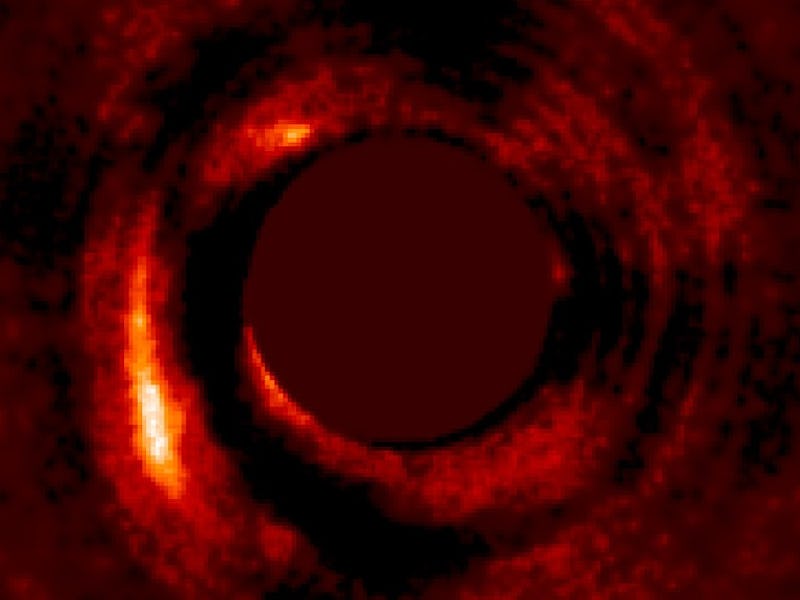Astronomers Caught a Rare Glimpse of an Exoplanet Being Born
The discovery provides further evidence for theories of how planets form.

While astronomers have discovered more than 5,000 exoplanets (other worlds orbiting other stars beyond our Sun), they’ve caught very few in the act of being born. In fact, until recently, they’d only found two — PDS b and PDS c, gas giant exoplanets orbiting a dwarf star about 370-light years from Earth in the constellation Centaurus.
But new research published in the Monthly Notices of the Royal Astronomical Society brings the count of confirmed protoplanets (planets that are still growing) to three after a team of Belgian and Australian scientists discovered the protoplanet HD 169142 b. They were able to obtain images of HD 169142 b carving a spiraling wake in the disk of dust surrounding a star 374-light years from Earth.
The discovery is not just an important addition to the small catalog of protoplanets but provides further evidence for theories of how planets form, namely by gathering dust, gas, and other material from the so-called protoplanetary disks that form in orbit around young stars.
“Given the very small number of confirmed forming planets to date, the discovery of this source and its follow-up should give us a better understanding of how planets, and in particular giant planets such as Jupiter, are formed,” co-author Valentin Christiaens, an astrophysicist at the University of Liege in Belgium, said in a statement.
Image of the HD 169142 system showing the signal of the forming planet HD 169142 b (around 11 o'clock), as well as a bright spiral arm resulting from the dynamic interaction between the planet and the disc in which it is located. The signal from the star, 100,000 times brighter than the planet, was subtracted by a combination of optical components and image processing (mask in the centre of the image). Observations at different times show the planet advancing in its orbit over time.
What a growing planet needs
A gas giant planet roughly the mass of Jupiter, and it may grow larger over time, HD 169142 b orbits its star at 37 times the distance from Earth to the Sun, which is a bit further out than the orbit of Neptune in our solar system.
In observations with the European Southern Observatory’s Very Large Telescope (VLT) from 2015 into 2019, the researchers were able to identify gaps in the protoplanetary disk surrounding the star HD 169142, along with the spirals in the gas and dust — just what you’d expect a giant, spinning proto-Jupiter would leave in its wake as it swung around its star and pulled in material with which to build itself up.
But the researchers not only managed to get images of a planet being born, they also found HD 169142 b was shrouded in dust, which could make up a circumplanetary disc. Think of it as a smaller-scale version of the protoplanetary disc around the star, except it's orbiting the protoplanet. It’s possible that moons will eventually coalesce out of this circumplanetary disc just as HD 169142 b is coalescing out of the protoplanetary disc around its star.
How the researchers did it
The Very Large Telescope is an array of four large optical telescopes located in Northern Chile. The researchers used one of the instruments at the VLT, the Spectro-Polarimetric High-contrast Exoplanet REsearch, or SPHERE, which uses adaptive optics technology to rapidly adjust the telescopes’ mirrors and lenses optics to cancel out the distorting effect of peering through Earth’s thick atmosphere. This allowed the team to study the HD 169142 system in infrared light.
“As we expect planets to be hot when they form, the telescope took infrared images of HD 169142 to look for the thermal signature of their formation. With these data, we were able to confirm the presence of a planet,” the lead author of the study and Monash University Ph.D. candidate Ian Hammond said in a statement. “In the infrared, we can also see a spiral arm in the disc, caused by the planet and visible in its wake.”
Why cataloging protoplanets is important
The discovery of HD 169142 b is important because it helps give astronomers a larger baseline against which to measure other possible protoplanetary discoveries.
“There have been many false positives among the detections of planets in formation over the last ten years,” Christiaens said. “The status of the other candidates is still hotly debated in the scientific community.”
Further study of the spiral wake left by HD 169142 b, particularly any future observations with the James Webb Space Telescope, could help astronomers find and confirm other protoplanetary discoveries, according to Hammond.
“Other protoplanetary discs containing spirals may also harbor yet undiscovered planets,” he said.